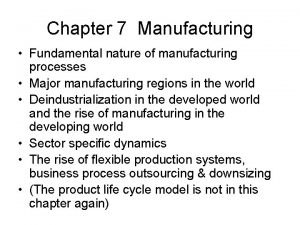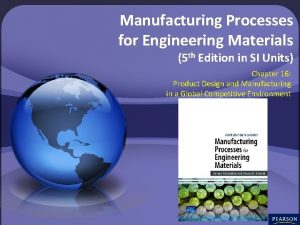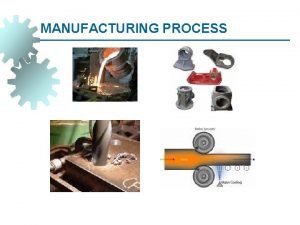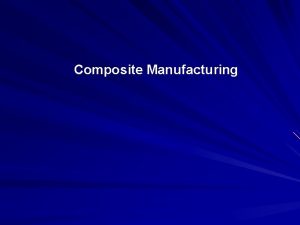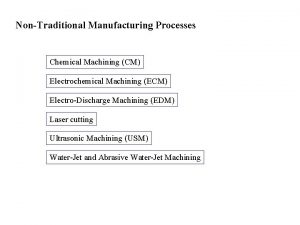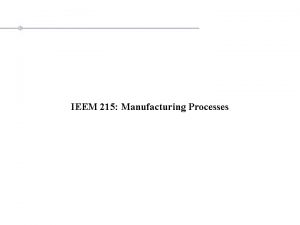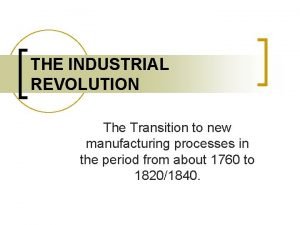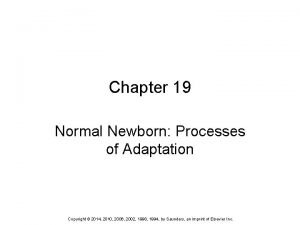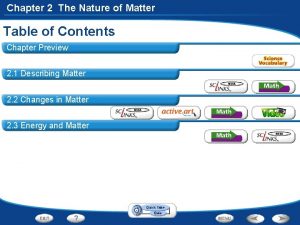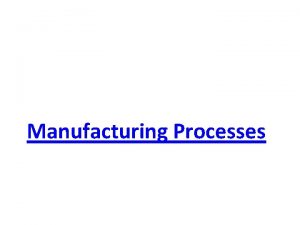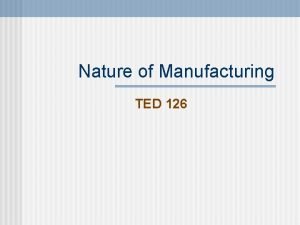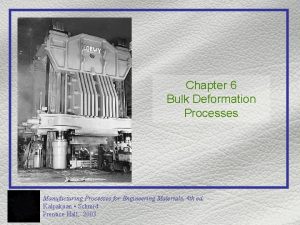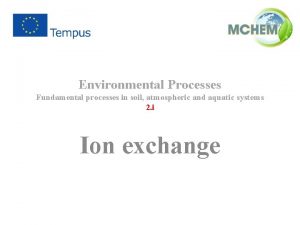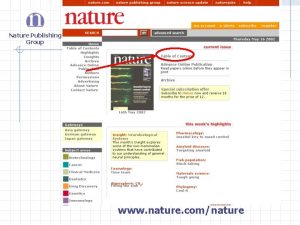Chapter 7 Manufacturing Fundamental nature of manufacturing processes







































- Slides: 39

Chapter 7 Manufacturing • Fundamental nature of manufacturing processes • Major manufacturing regions in the world • Recent global shifts in manufacturing • Trends in U. S. Manufacturing activity • The rise of flexible production systems

The Nature of Manufacturing • Elements of the manufacturing process: (a) product design, (b) assembling inputs, (c) transforming the inputs, (d) marketing the product • Location decision – Weber model again • Value added in each stage of production

Concentration of World Manufacturing 80% of Global Output in Three Regions How current are these data? Current role of China?

U. S. & Canadian Manufacturing Belt: Accounts For about Two-thirds of Total Manufacturing Employment in The U. S. and Canada

Specialization in the Regional Distribution of Manufacturing • Figure 7. 3 (216)– Textiles • Figure 7. 4(217) – Electronics • The following maps depict industries distributed broadly across the U. S. , and industries that are highly concentrated

Economic Areas – As of 1985











Other Manufacturing Regions • Europe ( Figure 7. 5)–萊因河下游、萊因河中 • • • 游、波河 Rissia ( Figure 7. 6) Japan - Figure 7. 7 Globalization of manufacturing – movement of capacity from U. S. & Canada, Europe, and Japan to less developed countries “The new international division of labor” “Anatomies of Job Loss”

Impacts on Manufacturing Jobs in U. S. , Europe and Japan • 1973石油危機之後 • Job losses in manufacturing in all of these regions(Bristain: 28%,France: 14%,U. S: 8%) • Relocation:low-wage industrializing periphery countries(East &south asia) increased • 『flying geese formation』:Japan-NICs

The Globalization of manufacturing “The traditional view is that deindustrialization in some places and industrialization in others are mirror images (鏡像)of each other. Industrial growth and decline are offsetting tendencies, representing a zero-sum(零和), or even positive, global game. The shift may lead to some transitional unemployment, but job losses in the industrial heartland are of little significance compared with the enormous rewards attached to a global relocation of production. ”

Globalization of Major Manufacturing Sectors • (1)Textiles & Garments(服飾業): classic • • • case of labor-cost deviation Figure 7. 8 小規模、低技術:由以開發國家一向開發中國家 (2)Steel – Movement to rapidly industrializing countries (Figure 7. 9 -7. 10 -7. 11) 資本密集、寡佔事業(oligopolistic)、原料取向: 20世紀由美國主控,1973以後(postfordist)轉 向開發中國家




Urban-Rural Manufacturing Trend 1991 -2004

International Movement of U. S. Manufacturing • Rise of F. D. I. (Foreign Direct investment) • Shifting locations of F. D. I. – 1945 -1960 Canada & Latin America – 1950’s Western Europe – 1960’s-1970’s – Europe – 1980’s-1990’s-south&east asia 美國海外投資仍以已開發區為主 • Cumulative employment abroad of 500 largest U. S. corporations equaled domestic employment • Most investment in advanced economies

Global Employment of U. S. MNC’s Cumulative employment abroad of 500 largest U. S. corporations equaled domestic employment

Key Trends for U. S. Manufacturers • Large overseas markets pull U. S. manufacturers into • • • them The growth of nontariff barriers(貿易壁壘) are forcing localization of production abroad (就地生產) Regional trading blocs push investment strategies and pull firms into these organizations to get benefits Shifting exchange rates are pushing firms to be flexible as to where they have capacity New manufacturing methods are reshaping the distribution of manufacturing capacity Large factories in low-skill labor regions are not sustainable

The Rise of Flexible Production Systems • The historic development of manufacturing moving from fragmented small-scale facilities to vertically integrated corporations – The Fordist Paradigm • The contemporary development of other paradigms – just-in-time; total-qualitycontrol; flexible manufacturing systems – Consequences of these new developments on plant size and labor force skills


The End of Fordism? The Flexibility Debate • Are we not only entering a new long- wave, where IT(information technology) is the driving force, but also a new longwave in which the basic structure of productive relations is in massive shift? • The Fordist paradigm - implicit in the oligoplistic model - but also linked to consumption and the regulation of society/consumption

Emergence of Flexible Specialization • Fragmentation of the Fordist firm - vertical disintegration (shedding non-central functions; outsourcing) and Market fragmentation • Adoption of new technologies, especially those dependent upon computers and telecommunications • Labor force adjustments – functional flexibility (multiskilling) – numeric flexibility (adjusting quantities by task) – financial flexibility (wage rate adjustment) – more part time, short-term, temporary work

The Post-Fordist System is also more efficient Role of IT within and between firms; logistics revolution

Business Process Reengineering • Division of labor rationalized • Employees are empowered to a greater degree • Work is undertaken where it makes most sense • geographically (recall the 787 production system) Internal structures are simplified / more coordinated and more decentralized

The “New Economy” • Rising productivity compared to recent years • The growing importance of IT producing industries • The growing productivity in IT using industries • Finally, investment in IT appears to be having an economy-wide impact

A Common Outcome of this Turbulence: The Product Life Cycle Sales Volume Initial Growth development Maturity Decline Obsolescence

Spatial Reorganization within Large Business Organizations • Dynamism in firm activities: their size, number, function, and geographic configuration • Inherent flexibility of multiplant firms - either in-situ (原地)change or locational shift LOCATIONAL SHIFTS IN SITU CHANGE Expansion Replacement (擴張) of existing capital stock Reduction of existing capital stock - Investment at new location(s) opening of branch plant(s) Acquisition (收購) of plant(s) owned by another firm Divestment of existing plant(s) closure or Disposal (轉讓) Relocation of entire plant and equipment

Evolution of Global Corporations Stage I 2 Stage II • • 1 o 2 3 Headquarters • Production plant o Sales subsidiary + Licensing arrangement Acquisition Exports + 4 3 Stage III 5 • 2 • • • 1 3 + 4

Evolution of Global Corporations Stage IV • 6 • 2 • • • 1 • o 8 3 Headquarters • 7 5 • Stage V • • 4 • 6 9 • 2 Production plant o Sales subsidiary + Licensing arrangement Acquisition(收購) Exports • 5 • • • 1 • 8 3 7 4 • 9

Summary • Global concentrations of manufacturing, but they • • • are not static(靜態) Capital moves from place to place in the search for profit Multinational corporations and processes of FDI have reshaped the geography of manufacturing Today Schumpeter’s process of “creative destruction” is fueled by IT, logistics, and the rise of new production regimes built around more flexible manufacturing systems
 Fundamental manufacturing processes
Fundamental manufacturing processes Concurrent in os
Concurrent in os Radical redesign of business processes
Radical redesign of business processes Manufacturing processes for engineering materials 5th
Manufacturing processes for engineering materials 5th Classification of production
Classification of production List of manufacturing processes
List of manufacturing processes Pultrusion process
Pultrusion process Nontraditional manufacturing processes
Nontraditional manufacturing processes Similar
Similar The transition to new manufacturing processes
The transition to new manufacturing processes Manufacturing cost vs non manufacturing cost
Manufacturing cost vs non manufacturing cost Job costing and process costing
Job costing and process costing Manufacturing cost vs non manufacturing cost
Manufacturing cost vs non manufacturing cost Manufacturing cost vs non manufacturing cost
Manufacturing cost vs non manufacturing cost Additively
Additively 4 fundamental forces of nature
4 fundamental forces of nature Nature of fundamental rights
Nature of fundamental rights Uses of radioactive isotopes in agriculture
Uses of radioactive isotopes in agriculture Nature and nature's laws lay hid in night meaning
Nature and nature's laws lay hid in night meaning Nature nature controversy
Nature nature controversy Chapter 19 normal newborn processes of adaptation
Chapter 19 normal newborn processes of adaptation Types of jaycustomers
Types of jaycustomers Fundamentals chapter 1
Fundamentals chapter 1 Prerequisites fundamental concepts of algebra
Prerequisites fundamental concepts of algebra Chapter p prerequisites fundamental concepts of algebra
Chapter p prerequisites fundamental concepts of algebra Chapter p prerequisites
Chapter p prerequisites Secam stands for
Secam stands for Nature of nurture chapter 3
Nature of nurture chapter 3 Nature of nurture chapter 3
Nature of nurture chapter 3 Chapter 9 section 1 the nature of interest groups
Chapter 9 section 1 the nature of interest groups Chapter 1 the nature of strategic management
Chapter 1 the nature of strategic management Chapter 10 lipids nature's flavor enhancers answers
Chapter 10 lipids nature's flavor enhancers answers Section 1 the nature of energy
Section 1 the nature of energy Nature of nurture chapter 3
Nature of nurture chapter 3 Nature of science chapter 1
Nature of science chapter 1 Chapter 8 lesson 1
Chapter 8 lesson 1 Chapter 4 basic food chemistry the nature of matter
Chapter 4 basic food chemistry the nature of matter Chapter 4 basic food chemistry the nature of matter
Chapter 4 basic food chemistry the nature of matter Foods that are heterogeneous mixtures
Foods that are heterogeneous mixtures The nature of matter chapter 2
The nature of matter chapter 2
